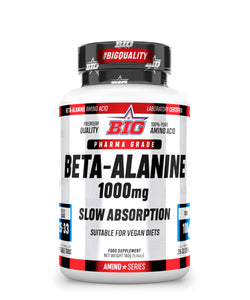
BETA ALANINE: SAY NO TO ITCHING, OR DO YOU?
Sergio Guerrero
INTRODUCTION
In this new Blog entry we will analyze the mechanism of action, uses, doses, formulas and side effects.

MECHANISM OF ACTION
Beta-alanine is a non-essential amino acid, this means that it is not a necessary part of the human diet because our bodies can create it from other amino acids.
Our body primarily uses beta-alanine to form a compound molecule called carnosine , which is stored in the muscles and brain (Fig. 1), and it does so by combining beta-alanine with an essential amino acid, L-histidine .
One of the roles of carnosine in our muscles is related to the regulation of acidity levels .
When multiple muscle contractions occur, our muscles become increasingly acidic , this, in turn , affects their ability to continue contracting , until eventually they can no longer contract at all.
Carnosine counteracts this by reducing muscle acidity, which increases the amount of work the muscles can do before fatigue .

- Figure 1: Carnosine synthesis process in skeletal muscle and brain.
FORMULATIONS, DOSAGE AND SIDE EFFECTS
If you have consumed beta-alanine in doses greater than 800 mg you will have noticed unpleasant sensory symptoms (paresthesia) . To alleviate this, the industry modified pure beta-alanine to a sustained release one. As seen in the study by Varanoske, AN et al., 2018, sustained-release beta-alanine was shown to prevent paresthesia and extend the period of supply to the muscle for carnosine synthesis .
For this, 39 subjects were recruited and divided into 3 groups, the first of them took rapid-acting beta-alanine (IR), group 2 sustained-release beta-alanine (SR), and group 3 a placebo. The dose of beta-alanine was 6 g/day for both formulations.
After 28 days, the results obtained were that participants who supplemented with the SR and IR formulations increased muscle carnosine content by 50.1% and 37.9% respectively (Fig.2). Although SR participants experienced a 16.4% greater increase in muscle carnosine than IR participants, fatigue during maximal voluntary isometric contractions was significantly attenuated in both SR and IR compared to the placebo group .

- Figure 2: Unadjusted values for skeletal muscle carnosine content before and after supplementation

- Figure 3: Unadjusted values for skeletal muscle β-alanine content before and after supplementation
Interestingly, only participants who consumed the SR formulation had elevations in muscle carnosine content that were significantly different from those who supplemented with placebo, while no significant differences were observed between those who supplemented with the RR formulation and participants who supplemented with placebo. were supplemented with placebo. However, a large effect size was observed for changes in carnosine content in participants consuming the RR formulation compared to placebo, suggesting that carnosine content was elevated with the RR formulation. Furthermore, although no significant differences in muscle carnosine were observed at post-study between participants consuming the SR and RR formulations, a 16.4% difference in muscle carnosine change between the groups provides an interesting result. . Estimated beta-alanine retention was calculated to be 6.8 ± 8.2 and 5.5 ± 6.1% for participants consuming SR and RR formulations, respectively.
Therefore, we conclude that both formulations work, but the sustained-release formulation prevents paresthesia. In addition, sustained-release formulations can increase the time during which beta-alanine rises in plasma (Decombaz et al. 2012 ), possibly increasing the potential for beta-alanine to be transported into muscle to form carnosine .
The pharmacokinetic difference between the rapid and sustained formulations may explain part of the mechanism behind the 16.4% difference observed between the two beta-alanine groups in the response of carnosine synthesis .

- Figure 4: Prospective projection of changes in intramuscular carnosine concentrations using a rapid release (RR) formulation compared to a sustained release (SR) formulation during different durations of β-alanine supplementation based on the kinetics presented by Spelnikov and Harris (2018)
Another way to alleviate paresthesia if it is fast-acting is to divide the dose throughout the day.
Doses? According to the bulk of the available evidence, they range between 3.2-6.4 g/day, with individual doses of 0.8-1.6 g every 3-4 hours throughout the day to avoid paresthesia. Unless that is what interests you, for example, in Real RIP beta-alanine was added to cause paresthesia and have a greater sensation of activation.
REFERENCES
- 1. Alyssa N. Varanoske, Jeffrey R. Stout, Jay R. Hoffman, Chapter 28 - Effects of β-Alanine Supplementation and Intramuscular Carnosine Content on Exercise Performance and Health, Editor(s): Debasis Bagchi, Sreejayan Nair, Chandan K. Sen, Nutrition and Enhanced Sports Performance (Second Edition), Academic Press, 2019, Pages 327-344, ISBN 9780128139226, https://doi.org/10.1016/B978-0-12-813922-6.00028-X
- Ament W, Verkerke GJ. Exercise and fatigue. Sports Med. 2009;39(5):389-422. doi: 10.2165/00007256-200939050-00005. PMID: 19402743.
- Décombaz J, Beaumont M, Vuichoud J, Bouisset F, Stellingwerff T. Effect of slow-release β-alanine tablets on absorption kinetics and paresthesia. Amino Acids. 2012 Jul;43(1):67-76. doi:10.1007/s00726-011-1169-7. Epub 2011 Dec 3. Erratum in: Amino Acids. 2013 Oct;45(4):1015. PMID: 22139410.
- Green HJ. Mechanisms of muscle fatigue in intense exercise. J Sports Sci. 1997 Jun;15(3):247-56. doi:10.1080/026404197367254. PMID: 9232550.
- Hobson RM, Saunders B, Ball G, Harris RC, Sale C. Effects of β-alanine supplementation on exercise performance: a meta-analysis. Amino Acids. 2012 Jul;43(1):25-37. doi:10.1007/s00726-011-1200-z. Epub 2012 Jan 24. PMID: 22270875; PMCID: PMC3374095.
- Hoffman JR, Landau G, Stout JR, Hoffman MW, Shavit N, Rosen P, Moran DS, Fukuda DH, Shelef I, Carmom E, Ostfeld I. β-Alanine ingestion increases muscle carnosine content and combat specific performance in soldiers. Amino Acids. 2015 Mar;47(3):627-36. doi:10.1007/s00726-014-1896-7. Epub 2014 Dec 16. PMID: 25510839; PMCID: PMC4326648.
- Varanoske AN, Hoffman JR, Church DD, Coker NA, Baker KM, Dodd SJ, Harris RC, Oliveira LP, Dawson VL, Wang R, Fukuda DH, Stout JR. Comparison of sustained-release and rapid-release β-alanine formulations on changes in skeletal muscle carnosine and histidine content and isometric performance following a muscle-damaging protocol. Amino Acids. 2019 Jan;51(1):49-60. doi:10.1007/s00726-018-2609-4. Epub 2018 Jul 12. PMID: 30003336.




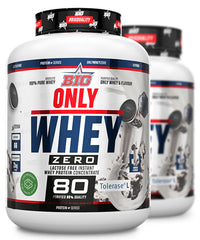
![CREABIG [Creapure®]](http://bigsupps.site/cdn/shop/products/producto_BIG_creabig_creapure_250g_0noflavour_500x600_8c48a126-a2a2-46a5-9bbd-8763ab82d768_200x.jpg?v=1757315967)
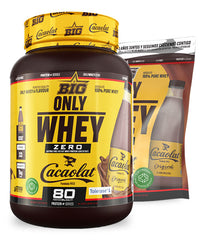
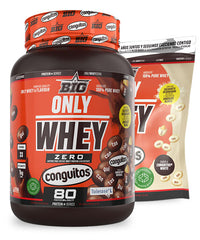

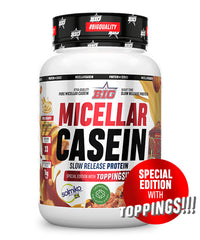
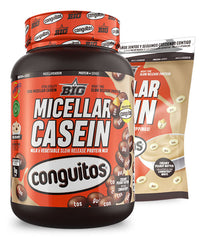
![CFM ISO ZERO [saco]](http://bigsupps.site/cdn/shop/files/producto_cfm_doypack_0noflavour_500x600a_200x.jpg?v=1750981452)
![CLEAR ISO ZERO [750g]](http://bigsupps.site/cdn/shop/files/producto_BIG_clearprotein_icepop_0noflavour_500x600a_200x.jpg?v=1757074297)
![CREABIG FIESTA® KOJAK® flavor - [250g]](http://bigsupps.site/cdn/shop/files/producto_BIG_creabig_kojak_0noflavour_500x600a_200x.jpg?v=1763548822)
